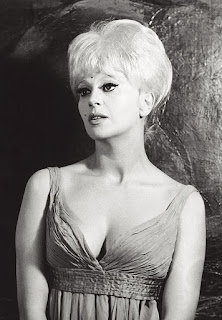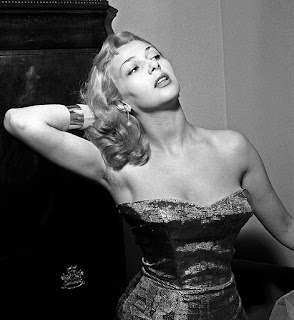Artistic collaborator and wife of Dario Fo
 |
| Franca Rame in a publicity shot from a brief but unsuccessful movie career |
The actress and writer Franca Rame, much of whose work was
done in collaboration with her husband, the Nobel Prize-winning actor,
playwright and satirist Dario Fo, died in Milan on this day in 2013 at the age
of 83.
One of Italy's most admired and respected stage performers, her
contribution to Dario Fo’s work was such that his 1997 Nobel prize for
literature probably should have been a joint award. In the event, on receipt of
the award, Fo announced he was sharing it with his wife.
Rame was also a left-wing militant. A member of the Italian
Communist Party from 1967, she was elected to the Italian senate in 2006 under
the banner of the Italy of Values party, a centre-left anti-corruption grouping
led by Antonio di Pietro, the former prosecutor who had led the Mani Pulite (“Clean
Hands”) corruption investigation in the 1990s.
Later she was an independent member of the Communist
Refoundation Party. Her political views
often heavily influenced her writing, in which her targets tended to be the
Italian government and the Roman Catholic Church. She was also an outspoken champion of women’s
rights.
Her politics made her some enemies, however. In 1973, she was kidnapped at gunpoint on a
Milan street by a group of neo-Fascist men who raped and tortured her. When she was released, the group said it
was revenge against her and Fo for their political activism.
 |
| Franca Rame in 1952, when she began her relationship with Dario Fo after they met through work |
Born in Parabiago, a town of almost 30,000 people in the
north-western quarter of the Milan metropolitan area, Rame was the daughter of
an actor and a militant socialist father and a strict Catholic mother. She was
almost born on the stage, appearing in a performance with her mother when she
was only eight days old.
At the age of 18, and with the photogenic looks of a 1950s
blonde bombshell, she began a theatre career in Milan. She met Dario Fo when
they were members of the same company. Fo was smitten from an early stage and
to his surprise and delight the attraction was mutual. They married in 1954 and their son
Jacopo, now himself a writer, was born in 1955.
Rame had a brief but only modestly successful movie career before switching her focus to the theatre. As a professional partnership, she and Fo's first hit, Gli
Arcangeli non Giacano a Flipper – Archangels Don’t Play Pinball – played at the
Odeon theatre in Milan in 1959, where they were subsequently invited to write
and perform a new play every year.
Subsequent successes included Isabella, Tre Caravelle e un
Cacciaballe – Isabella, Three Sailing Ships and a Con Man – set in Spain in the
early years of the inquisition, in which Rame played Queen Isabella.
 |
| Dario Fo with Franca Rame and their son Jacopo |
In time, however, they gave up commercial theatre in favour
of forming co-operative groups and in 1970 founded their own militant theatre group,
La Comune, based at the Palazzina Liberty, an abandoned pavilion. It was there
that Rame starred in Fo’s acclaimed Non Si Paga! Non Si Paga! (Can’t Pay? Won’t
Pay!) and that she wrote and performed in a one-woman show Tutta Casa, Letto e
Chiesa (It’s All Bed, Board and Church).
Their relationship was turbulent at times and at one stage
she announced their separation. Yet they patched up their differences and even
sent themselves up in a play, Coppia Aperta (The Open Couple).
Rame and Fo were particularly despairing of Italy’s support
for Silvio Berlusconi when the country shifted to the right in the 1990s, even more
when he was granted a return to power in 2001. Their play L’Anomalo Bicefalo
(The Two Headed Anomaly), a satire about a political rally in Sicily which
features an assassination attempt on Berlusconi and the Russian leader Vladimir
Putin, infuriated Berlusconi when Rame’s performance in a comic scene as his
wife, Veronica, was praised by Veronica herself.
Her opposition to Berlusconi was part of her motivation for
joining forces with Di Pietro, for whom Berlusconi’s scorn had been undisguised
during the Mani Pulite trials, prior to her election to the senate.
 |
| The Prepositurale church in Parabiago |
Travel tip:
Parabiago grew as an industrial centre in the 1960s, when its
footwear industry, established in the late 19th century, enjoyed a
boom. It became known as The City of the Shoe. Notable churches include the Prepositurale
church dedicated to saints Gervasio and Protasio, built in 1610 on the orders
of the Bishop of Milan, San Carlo Borromeo. The neoclassical façade, added between
1780 and 1781, was designed by Giuseppe Piermarini. Parabiago is also home to Villa
Maggi-Corvini , or simply Villa Corvini, located at the beginning of the historic
Via Santa Maria. The villa is part of the Parco Corvini municipal park, which
is open to the public.
 |
| The Palazzina Liberty used to be the cafeteria-restaurant at the Verziere market in Milan |
Travel tip:
The Palazzina Liberty in Milan’s Parco Vittorio Formentano,
on the eastern side of the city centre, was built in 1908 to house the cafeteria-restaurant
in the Verziere fruit and vegetable market but fell into disuse when the market
moved to a different location. Dario Fo took it over in the 1970s and in 1980
it became home to Milan’s civic orchestra before being renovated in 1992 and
opened as a cultural and recreational facility for the city, hosting orchestral
concerts, film festivals and poetry events among other things.
More reading:
Enrico Berlinguer - the politician who put Italian Communism on the map
How Dario Fo put the spotlight on corruption in Italian government
Books of Leonardo Sciascia put spotlight on corruption in Sicily
Also on this day:
1926: The birth in Italy of English TV personality Katie Boyle


